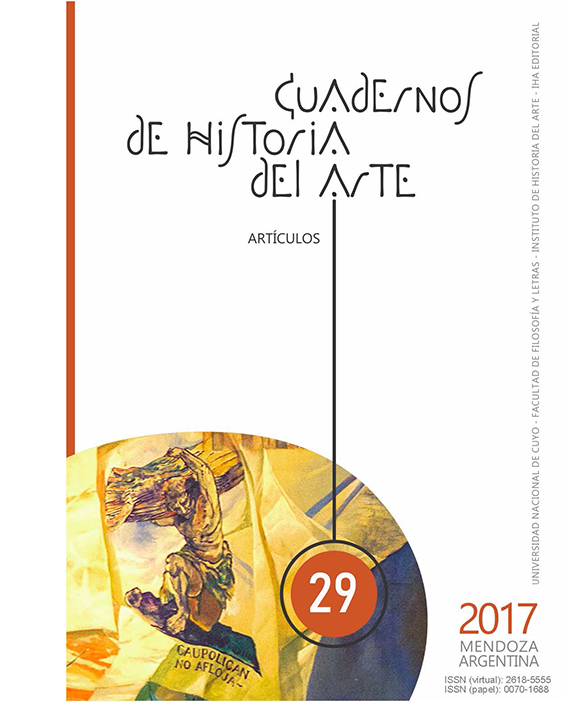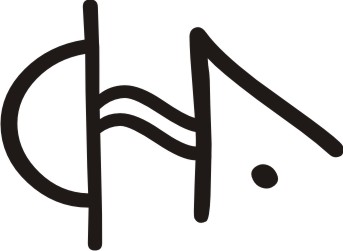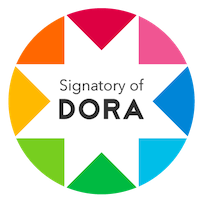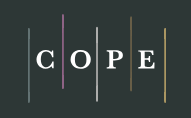Pintura, Independência e Educação. A evolução das Belas Artes chilenas no século XIX
Palavras-chave:
Educación artística, Pintura, Chile, Emancipación, Artistic education, Painting, Emancipation, Educação Artistica, Emancipação.Resumo
O prusiano vinculava determinadas condições políticas, geográficas e climáticas com a criação de um contexto favorável ao florescimento das Artes. Em Santiago todas as circunstâncias se estavam dando naquela época, assim que Ciccarelli pôs ao jovem Páis o lisongeiro apelido de "Atenas de América do Sul".
A apreciável evolução das Belas Artes chilenas na passagem desde o século XVIII ao XIX tem seu raison d’etre em dois fatores: o primeiro foi o impulso dado à sistematização dos estudos artísticos na formação dos jovens artistas. A partir de 1796 com a fundação em Santiago da Academia de San Luis graças aos esforços do ilustrado santiaguino Manuel de Salas começaram a se estabelecer as necessárias formas de institucionalização acadêmica que reconheceram no desenho a disciplina fundamental no processo de aprendizagem artística.
A partir do século XIX o Instituto Nacional, a Academia de Pintura e outras instituições preocuparam-se de canalizar os estudos artísticos orientados a uma perspectiva vinculada mais às Belas Artes que ao âmbito da indústria e da agricultura.
A pintura chilena experimentou então um câmbio de tendências artísticas que a dirigirão até formas que em 1969 Antonio Romera definiu felizmente de um "romancismo tropical", e que em nossa opinião têm no francês Monvoisin seu melhor intérprete.
Esta consideração nos leva diretamente ao segundo fator, isso é, a presença no solo chileno de artistas estrangeiros, os "viageiros" que além de introduzir câmbios estilísticos inovadores no panorama da pintura chilena, agilizam a circulação de tratados de arte, livros e estampas que desde Europa alimentou uma verdadeira reforma do discurso por volta de questões estéticas e de gosto.
Nas seguintes páginas demonstraremos como estas circunstâncias dialogando entre si graças a um contexto social e sobre tudo político que o permitiu, favoreceram um verdadeiro florescimento das Belas Artes no Chile.
Prova disso foram as palavras pronunciadas em 1849 pelo pintor italiano Alessandro Ciccarelli em ocasião do discurso inicial para a inauguração da nomeada Academia de Pintura. Referindo-se a seu projeto educativo para levantar as condições das Belas Artes chilenas, aplica o magnífico sistema que o teórico Winckelmann em 1764 tinha aplicado ao estudo da História da Arte da Grécia do V século a.C.
Referências
AAVV., Historia de Chile, 1808-1994, (Cambridge: Cambridge University Press, 1998).
AAVV.. La misión y los jesuitas en la América española, 1566-1767: cambios y permanencias, (Madrid: Consejo Superior de Investigaciones Científicas, 2005).
AMUNATEGUI Miguel Luis, Los precursores de la Independencia de Chile, (Santiago: Imprenta Litografía i Encuadernación Barcelona, 1910).
AMUNATEGUI, Miguel Luis. "Apuntes sobre lo que han sido las Bellas Artes en Chile", en Revista de Santiago, (Santiago de Chile: Imp. Chilena, abril 1849), , n.II, pp 37-47.
AMUNATEGUI, Miguel Luis. Don Manuel de Salas, (Santiago de Chile: Imprenta Nacional, 1895).
AMUNATEGUI SOLAR, Domingo. Los primeros años del Instituto Nacional, (Santiago de Chile, Imprenta Cervantes, 1889).
ARANEDA BRAVO, Fidel. El barroco jesuita chileno, (Concepción: Eds. Revista Atenea, 1965).
BERRÍOS, Pablo. Del taller a las aulas: la institución moderna del arte en Chile (1797-1910), (Santiago: Estudios de Arte, 2009).
BÖHM, Günther. "Artistas Judíos en Chile en el Siglo XIX", Separata de la Revista Judaica Iberoamericana, Nº 2, (Santiago, Ed. Universidad de Chile, 1978).
BRAVO LIRA, Bernardino. El Barroco en Hispanoamérica: manifestaciones y significación, Fondo Histórico y Bibliográfico José Toribio Medina, (Santiago: Imprenta Nacional, 1938).
CAMPOS HARRIET, Fernando et al.. Estudios sobre la época de Carlos III en el reino de Chile, (Santiago: Ediciones de la Universidad de Chile, 1989).
CELIS MUÑOZ, Luis. "Manuel de Salas. Pensamiento educativo en tiempo de transición", en Revista Pensamiento Educativo, (Santiago: Ed. Pontificia Universidad Católica de Chile, junio 2004) n. 34, 1, pp. 18-27.
CICCARELLI, Alejandro y CHACÓN, Jacinto. Discurso pronunciado en la inauguración de la Academia de Pintura por su director Alejandro Ciccarelli: seguido de la contestación en verso leída por D. Jacinto Chacón, (Santiago: Imprenta Chilena, 1849.
CRUZ OVALLE, Isabel. Arte: lo mejor en la historia de la pintura y escultura en Chile, (Santiago de Chile: Ed. Antártica, 1984), Pt 10, cap. I, 57-112.
DUARTE GUTIÉRREZ, Patricio. "Razón de identidad histórica y posibilidades de expresión en el espacio público de Independencia", en Revista de Urbanismo, n. 4, (Santiago de Chile: Ed. Universidad de Chile, 2001), pp. 1-38.
FERNÁNDEZ DÍAZ, Roberto. Carlos III. (Madrid: Arlanza, 2001).
FRONTAURA Y ARANA, José Manuel. Historia del Convictorio Carolino, (Santiago de Chile: Imprenta Nacional, 1889).
JAKSIC, Iván. "Sarmiento y la prensa chilena del siglo XIX", en Historia, n. 26 (Santiago de Chile: Instituto de Historia de la Universidad Católica de Chile, 1991), pp. 117-144.
JAKSIC, Iván. Andrés Bello: La pasión por el orden, (Santiago de Chile: Ed. Universitaria, 2010).
JOCELYN -HOLT Alfredo, El peso de la noche: nuestra frágil fortaleza histórica; José Gil de Castro y la Nueva Sensibilidad. (Santiago: Ed. Planeta,1999).
LASTARRIA, José Victorino. Discurso de incorporación de D. J. Victorino Lastarria a una Sociedad de Literatura de Santiago, en la sesión del tres de mayo de 1842, (Valparaíso, Impr. de M. Rivadeneyra, 1842).
MAJLUF, Natalia, José Gil de Castro. Pintor de libertadores. Catálogo de la exposición, (Lima: Asociación Museo de Arte de Lima, 2014).
MESA, José de y GISBERT, Teresa. Historia de la pintura cuzqueña, (Lima, Fundación A.N. Wiese, 1982).
MODIANO, Ignacio. Toesca: arquitecto itinerante de la tradición clásica del siglo XVIII y otros ensayos, (Santiago de Chile: Eds. Del Pirata, 1955).
PANIAGUA PÉREZ, Jesús. España y América entre el Barroco y la Ilustración (1722-1804): II Centenario de la muerte del Cardenal Lorenzana (1804-2004), (León, Ed. Universidad de León, 2005).
PEREIRA SALAS, Eugenio, Historia del Arte del Reino de Chile, (Santiago de Chile, Ed. Universidad de Chile, 1965.
RÁBAGO CORDERO, Ana Silvia. "El concepto de literatura en Chile durante la década de 1840: José Victorino Lastarria y la Sociedad Literaria", en Históricas, Boletín del Instituto de Investigaciones Históricas de la UNAM, n. 100 (México DF: Ed. Universidad Nacional Autónoma de México, mayo-agosto 2014), pp. 29- 40.
RÁMIREZ RIVERA, Hugo Rodolfo, Fuentes para el estudio de la Historia de Chile,(Santiago de Chile: UNESCO, Dirección de Bibliotecas, Archivos y Museos, 1984).
RIPAMONTI MONTT, Valentina. "Academia de Pintura en Chile. Sus momentos previos", en Intus- Legere: Historia 4-1, (Santiago: Ed. Universidad Adolfo Ibañez, 2010), pp. 127-156.
ROETTGEN, Steffi. Anton Raphael Mengs: 1728-1779, (Munich: Hirmer, 2003).
ROMERA, ANTONIO. Asedio a la Pintura Chilena (Desde el Mulato Gil de Castro a los Bodegones Literarios de Luis Durand, (Santiago de Chile: Editorial Nascimento, 1969).
SALAS, Manuel. Escritos de Don Manuel de Salas: y documentos relativos a él y a su familia, (Santiago de Chile: Ed. Universidad de Chile, 1914).
SERRANO, Sol. "La Revolución Francesa y la formación nacional de educación en Chile", en KREBS Ricardo y GAZMURI Cristian, La Revolución Francesa y Chile, (Santiago de Chile: Universitaria 1990), pp. 247-275.
SILVA CASTRO, Raúl. Prensa y periodismo en Chile: (1812-1956), (Santiago de Chile: Biblioteca Nacional de Chile, 2002).
STUVEN, Ana María. "La generación de 1842 y la conciencia nacional chilena", en Revista de Ciencia Política, n. 1, vol. IX (Santiago: Pontificia Universidad Católica de Chile, 1987), p. 61-80.
ÚBEDA DE LOS COBOS, Andrés. Pensamiento artístico español del siglo XVIII. De Antonio Palomino a Francisco de Goya, (Madrid: Museo Nacional del Prado, 2001).
VILLEGAS VERGARA, Lautaro Ignacio, et al.. Dibujo en Chile (1797-1999). Variaciones epistemológicas, aplicaciones profesionales (Santiago: Lom Ediciones, 2017).
Fuentes Documentales consultadas
Archivo Nacional de Chile (ANC), Fondo Vario, volúmenes: 175; 254; 275; 747; 749; 754; 801.
ANC, Fondo Vario, vol. 280, ff 15, Decreto de la Junta Nacional de Gobierno que incorpora la Universidad de san Felipe al Instituto Nacional. Firmado en el Palacio de Gobierno: Francisco Antonio Pérez, Agustín de Ayzaguirre, Juan de Egaña, José Tadeo Mancheño, Santiago de Chile, 2 de agosto de 1813.
ANC, Fondo Vario, vol. 155, ff 43-44, Carta de Manuel de Salas enviada al Gobernador (Presidente) de Chile Luis Muños de Guzmán, 12 de agosto de 1802.
ANC, Fondo Vario, vol. 156 ff.26-27, Carta de Manuel de Salas, del 11 de abril de 1811, dirigida al Presidente y a los vocales de la Junta Provisional de Gobierno.
Downloads
Publicado
Como Citar
Edição
Seção
Licença
Copyright (c) 2018 Cuadernos de Historia del Arte

Este trabalho é licenciado sob uma licença Creative Commons Attribution-NonCommercial-ShareAlike 3.0 Unported License.
Los artículos enviados al Comité Editor del Instituto de Historia del Arte, para ser publicados, los autores reservan su derecho de propiedad, pero otorgan a la Editorial los derechos de impresión y aceptan la difusión tanto en papel, como en internet y en aquellos sitios virtuales de las cuales los CHA formen parte.

Esta obra está bajo una Licencia Creative Commons Atribución-NoComercial-CompartirIgual 3.0 No portada


















_00.07_.55_2.png)





